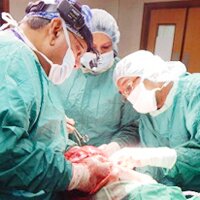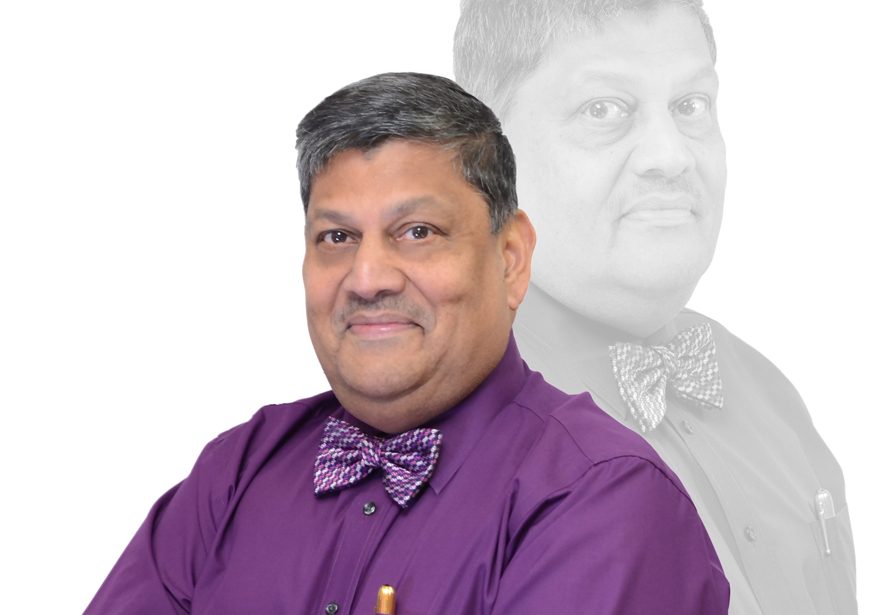Twenty-two years after his contributions to the field of medicine made him the nation’s youngest recipient of the Chaconia Gold Medal, Dr. Sawh has made medical history again.
In December 2015, Dr. Lall Ramnath Sawh, CMT., MB., FRCS, led a surgical team to remove the largest recorded kidney tumour in the western hemisphere, and the second largest in the world.
The largest recorded kidney tumour in the western hemisphere, and the second largest in the worldIt was a career milestone that, only a few weeks prior, he had not anticipated.
Named among the top 100 Health Professionals in the World, Dr. Sawh, who was featured earlier on WellnessConnect, has been a pioneer in the field of Urological Surgery for over three decades — during which time he had never encountered a tumour of that size.
The tumour, which was removed from the left kidney of a 52-year-old man, weighed eight pounds — a considerable measurement, in comparison to the largest tumour in the world that has been successfully removed, which weighed in at 5.018 kilos or approximately 11 pounds.
Lead surgeon and urologist Dr. Lall Sawh worked in collaboration with general vascular surgeon Dr. Steve Budhooram, and anaesthetist and intensivist Dr. Peng Ewe, to complete the three-hour long surgery at Southern Medical Clinic in San Fernando, south Trinidad on December 2nd, 2015.
“It was a very dangerous surgery, in that there were several pre-existing medical conditions, and anatomical challenges as the tumour was attached to vital structures and altered the normal anatomy severely,” says Dr. Sawh. “But the moment I saw the patient, I knew immediately that if the growth was not removed, he would soon die.”
When you are faced with such a big challenge, you can’t run from itIt was a case that some eager doctors may hope to see once in their lifetime — and one that many may secretly hope to avoid.
“Putting your career on the line, as a surgeon — you can’t take this lightly; not at all,” says Dr. Sawh. “But when you are faced with such a big challenge, you can’t run from it. You can’t hesitate, when a delay could make it worse for your patient. You have to act.”
The Tumour: Case Details
The 52-year-old patient, whose name was not released due to his wish for privacy, had developed the large mass in his kidney over the course of approximately a year. He did not, however, experience the common symptoms of a kidney tumour, which include pain and blood in the urine.

Having attempted natural remedies on his own to treat his extended stomach, the patient eventually reached out to Dr. Sawh on the recommendation of a pharmacist.
At the time he consulted Dr. Sawh on November 20th 2015, the size of the growing mass gave the visual impression of an advanced pregnancy. The scans he brought with him had only been taken eight days earlier.
The visual impression of an advanced pregnancy“As the mass grew, he had been losing a lot of weight, because the tumour was acting like a parasite on his body by absorbing nutrients and literally tapping his reserves,” explains Dr. Sawh.
The tumour was so large that it had pushed up the patient’s diaphragm, left lung and heart; and was also going into his pelvis. It had also pushed his major blood vessels, which are normally located in the middle, to the right. The patient also suffered from scoliosis, a spine curvature that compromised the available space within which to operate.
These issues presented significant concerns for the surgery. Even before the first surgical incision, preparing the patient with anesthesia required careful attention, as there was little space for the lung to expand, and the cardiac system was also compromised.
For the first time in his 35-year medical career, Dr. Sawh made a patient sign a consent form to acknowledge that he could die on the operating table.
A consent form to acknowledge that he could die on the operating table“Doctors can give predictions and percentages, but the truth is that historical data is inconsequential with regard to any particular case,” admits Dr. Sawh. “We always discuss any potential surgical risks with the patient, but for the first time for me, the chances of mortality during surgery were very real.”
Nonetheless, the surgical trio — ably supported by scrub nurse and head operating theatre nurse, Susan Maharaj, and her team of Moncy Mathew and the theatre staff — executed all procedures as planned; and the patient came through the surgery successfully.
He remained in the Intensive Care Unit (ICU) for the first 24 hours, and was able to return home only three days post-operatively, following which he had a two-week recovery period.
Surgical Excellence in T&T
The execution of any surgery, particularly one with such high risks, is no small feat.
You prepare to operate like a pilot on a simulatorDr. Sawh recalls that the two weeks he spent between meeting the patient and performing the surgery took a personal toll.
“As a surgeon, you prepare to operate like a pilot on a simulator, and go through all the various scenarios,” he says.
“Usually, with any surgery, I wake up in the wee morning hours a few times in the days prior to the surgery, and go through what could go wrong and how to act in each instance. But with this particular surgery it ‘haunted’ me for the entire two weeks, as I consciously planned ahead.”
The gravity of what they had accomplished only hit him in the aftermath.
“I attended a Society of Surgeons meeting on that same night, where one topic was ‘innovative surgeries’,” he recalls. “It wasn’t until I arrived home later that I realised: an innovative surgery had just happened today, right on our doorstep, and I was part of it.”
The case, which will be published in an international medical journal, was a milestone for the country, and one that has brought positive global attention to the precision and skill of our local medical professionals.
Dr. Sawh points out also that the expertise available locally also provides excellent value for money; the cost of this surgery was only a miniscule fraction of the estimated cost if the patient had attempted to seek treatment abroad.
In our humble way, we do great things“There are a lot of bad things that we often hear about surgery and medical mishaps; these always seem ‘celebratory’ to the media. But there are so many good things happening under the radar as well,” adds Dr. Sawh, who credits the success of the historical surgery to the competence of all those involved in its execution.
“As doctors, we take these successes quietly and move on to the next one — the next life we may change. But in our humble way, we do great things.”
WellnessConnect extends our congratulations to Dr. Sawh and the team of medical professionals, and our best wishes to the patient and his family.

